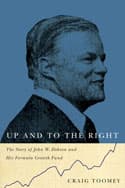
Book Review
Up and to the Right: The Story of John W. Dobson and His Formula Growth Fund, 2013
By Craig Toomey
Buy the book: https://www.mqup.ca/up-and-to-the-right-products-9780773543799.php
Journalist Craig Toomey’s Up and to the Right: The Story of John W. Dobson and His Formula Growth Fund details the life and entrepreneurial endeavours of John Dobson. Specifically, Toomey highlights the rise, successes, and tribulations of Dobson’s Formula Growth Fund, tracing it from its humble beginnings as an investment club to its current standing as one of Canada’s top investment management firms. The book is written in such a way as to appeal to the experienced business historian, MBA student, commerce undergrad, aspiring entrepreneur, or friends and colleagues of Dobson.
The business historian will appreciate Toomey’s micro-history of the Formula Growth Fund. Toomey combines interviews with former and current Formula Growth Fund investors, executives, and employees with insights from Dobson’s personal papers to outline not only Dobson’s life story, but also the humble beginnings of the Formula Growth Fund on June 27, 1960. From its start as an investment club, Toomey shows his readers how the investment club grew into a full time job for Dobson, experiencing immense growth in just its first two years of existence. However, Toomey’s history of the Formula Growth Fund does not shine a spotlight only on the firm’s successes, but also highlights some of its failures, such as passing on an opportunity to invest in Wal-Mart in its formative years. Throughout the book, Toomey conveys to readers the ups and downs of an investment firm, detailing how a firm’s success and failures are as much tied to investment strategies and principles as they are to political, economic, and technological events. We learn that the Formula Growth Fund, despite its massive success, experienced downturns due to market shocks caused by events such as the Cuban Missile Crisis, the OPEC Oil Embargo, Black Monday, and the Dot Com bubble.
In addition to contextualizing the peaks and valleys of the Formula Growth Fund, Toomey provides a portrait of one of Canada’s most important investors in the 20th century. Toomey details Dobson’s relationship with his father, Sydney Dobson, who was appointed as the President of the Royal Bank in 1947. We learn that John’s fervent belief in less government regulations and the ability of free markets to create wealth for Canadians came from his father Sydney. Toomey also pays close attention to Dobson’s educational path, showcasing to readers not only Dobson’s incredible academic achievements (e.g. Dobson was the youngest MBA student in his class at Harvard), but also Dobson’s lifelong belief in the importance of teaching entrepreneurship at Canadian Business schools. The reader learns that Dobson viewed investing as more of an art than a science and believed that training in entrepreneurship was an important complement to the statistics taught by economists in business school programs.
For the aspiring entrepreneur or manager, Toomey’s attention to the characteristics of Dobson’s personality that led to his success are important to consider. We learn that Dobson was a man that believed in the importance of punctuality, paid very close attention to detail, and was not fond of compromising. However, the reader also comes to know Dobson as generous, humble, and an eternal optimist. As Toomey details through interviews with Dobson’s colleagues and friends, these attributes helped Dobson weather the ups and downs of the market and attempts by his partners to force him out of the Formula Growth Fund in the mid 1970s. These personality features, so often focused upon by those who knew Dobson, provide an image of the type of personality attributes essential to the operation of a successful investment firm.
However, Toomey does not link Dobson’s success solely to his personality. Throughout the book we learn of the key principles and strategies that guided and continue to guide the Formula Growth Fund. We learn that Dobson placed an enormous amount of importance on meeting with shareholders and management of companies he considered investing in, and how these personal connections helped Dobson gain his legendary ability to identify emergent growth companies before they became big names, such as Home Depot. For the Canadian business historian, we learn of the origins of the Dobson Dinners and how these exclusive dinners were part of the Formula Growth Fund’s strategy to network with people that held critical insights on potential companies the firm could invest in.
The one topic that the book does not cover in much detail is the history of Canada during the rise of the Formula Growth Fund. Toomey delves briefly into a discussion of the introduction of Canada’s Capital Gains Tax in the 1970s, and Dobson’s decades long fight to remove this tax, but little else is covered on this topic. It stands to reason that the focus of the Formula Growth Fund’s investment were in international markets, predominantly in the United States, but a focus on the importance of the Dobson’s firm to Canadian business history is left to the reader to infer. It is clear that John Dobson has had an immense impact on both Canadian business history and the study of Canadian Business through his Dobson Foundation, but more attention to the impact or non-impact of different Canadian government policies, or economic trends, from the firm’s beginnings in 1960 to today would prove of great interest to the Canadian Business Historian.
With that being said, the book proves to be a useful tool for business historians, aspiring entrepreneurs and managers interested in the growth of one of Canada’s largest management investment firms. Up and to the Right is also a touching remembrance for Dobson’s friends and colleagues. Written in a way that is both educational and entertaining, Toomey provides what will surely be a key text in Canadian Business History and entrepreneurship curriculums for years to come.
Justin Douglas
University of Toronto